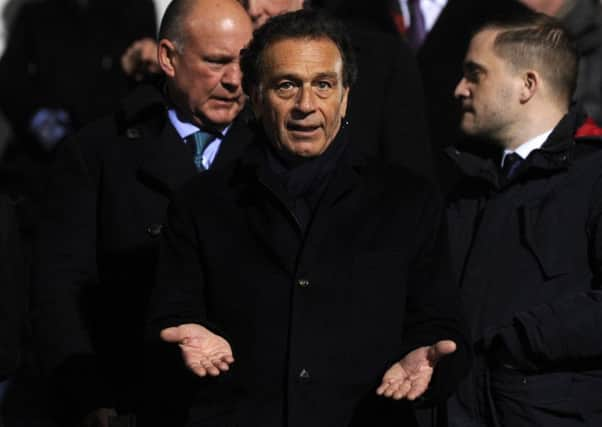Leeds United steering away from being a car crash club '“ Hay


When Leeds United publish their latest results, the figures will outline the club’s financial performance in the 12 months before July 2015.
Accounts are never the equivalent of opening the books, or opening the books as they are today.
Advertisement
Hide AdAdvertisement
Hide AdRegardless of that, United’s results for the 2014-15 year should be fascinating.
It is the first full accounting period on Massimo Cellino’s watch and the first in which the club’s strategy was dictated solely by him (accepting, of course, that between January 2015 and May 2015 he was disqualified as a director and officially banned from pulling strings at Elland Road).
Those accounts are due to be published on March 31 but a copy of Leeds’ interim results were submitted to the Football League before Christmas to demonstrate that United were compliant with Financial Fair Play (FFP) rules.
Steve Evans, the club’s head coach, claims the improvement in financial terms is “nothing short of remarkable” compared to the miserable picture in July 2014.
So how remarkable is remarkable?
Advertisement
Hide AdAdvertisement
Hide AdTo recap, United’s performance in the 2013-14 year was more desperate than it had been since 2007 and the summer of insolvency. In a long strategic report, Cellino described Leeds as being in a “perilous state” and a “critical condition” after his buy-out of Gulf Finance House. The club’s losses stood at just under £23m. Their wage bill had risen to £22.8m – 88 per cent of turnover and, in context, £6m higher that the wage bills carried by Middlesbrough and Derby County in the same 12 months – and “administrative expenses” came in at more than £37m.
The accounts also showed sizeable debts, bloated by £20m owed to GFH (on which the bank earned annual interest of more than £300,000) and loans from Cellino, his UK firm Eleonora Sport Limited and another connected company totalling £12m. Cellino said reaching a position of stability would take “12 to 18 months from this report date”.
Among the inevitable consequences of those figures was a transfer embargo in January of last year.
Leeds were comfortably in breach of the Football League’s FFP limits but the lifting of that embargo the following summer and the absence of any restrictions in this transfer window – confirmed beyond doubt by the £575,000 signing of Toumani Diagouraga from Brentford – point to a large drop in the losses posted in 2014-15.
Advertisement
Hide AdAdvertisement
Hide AdThe exact sum, which Leeds will confirm in March, is expected to be in ‘single figures’, some distance below the £22.8m recorded in 2013-14. Many at Elland Road believe the losses will fall somewhere between £3m and £4m. Asked to comment by the YEP, Cellino indicated that the figure would be closer to £2m and potentially as low as £1.8m. It sounds implausible until you consider that FFP rules restricted clubs in 2014-15 to a maximum loss of £6m, with shareholder investment no higher than £3m. Leeds found a way to meet those limits.
The club were helped no end by the cash raised from the sale of Ross McCormack to Fulham in July 2014. Back then, Cellino claimed the income from that transfer was in excess of £10m.
Companies House also show that millions of pounds were exchanged for shares in Leeds United Football Club limited shortly before the end of the 2014-15 financial year.
The wage bill during those 12 months is understood to have dropped to £19m – it is currently believed to stand at around £13m – and a reduction in that specific expense was one of Cellino’s priorities when he bought the club. It is a reason why so many staff have moved on and a prime reason why Sam Byram was asked to take a drop in salary.
Advertisement
Hide AdAdvertisement
Hide AdCellino says he was also able to make further substantial savings on the administrative side, including cuts to cash which he claims GFH was earning through “invoices”.
That is not to say that GFH is no longer owed money by Leeds. Its Share Purchase Agreement (SPA) with Cellino detailed debts of £24m and the 2013-14 accounts showed more than £20m owing.
The Italian tried various ways of reducing or negating those loans but the last time he spoke about it, he implied that he had reached an agreement where Leeds would repay money to GFH in manageable, annual installments until the debts were settled. Assuming that agreement is still in place, repayment will take more than 10 years.
It is that sort of issue which complicates the basic results which Leeds are due to publish at the end of March. The club have liabilities in the background which could cost the club, cost Cellino or cost any other investor heavily – employment tribunals, the disputes with Macron and Enterprise Insurance.
Advertisement
Hide AdAdvertisement
Hide AdAn intriguing factor in the forthcoming accounts will be the scale of the loans owed by United and the identity of the parties they are owed to.
Between GFH’s debts and money put up by Cellino and his companies, Leeds were shown to have borrowed in excess of £32m by the end of the 2013-14 year. Cellino said shortly after his takeover that any money he was loaning to United might later be converted into equity.
Given the never-ending threat to his ownership posed by the Football League, it remains to be seen whether a conversion has taken place.
Furthermore, Cellino admits that Leeds are unlikely to perform as well financially in this year as they did in 2014-15, but FFP rules allow for larger losses in 2015-16 and those figures will not be made public for another 14 months.
Whatever criticism can be aimed at Cellino, whatever else he gets wrong, the pending accounts are likely to show that Leeds are no longer the unmitigated train wreck they were when GFH bailed out.